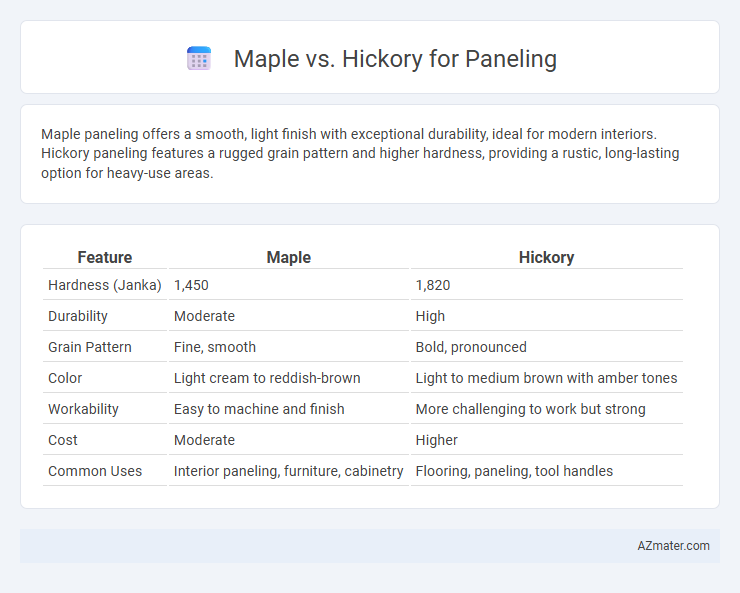Maple paneling offers a smooth, light finish with exceptional durability, ideal for modern interiors. Hickory paneling features a rugged grain pattern and higher hardness, providing a rustic, long-lasting option for heavy-use areas.
Table of Comparison
| Feature | Maple | Hickory |
|---|---|---|
| Hardness (Janka) | 1,450 | 1,820 |
| Durability | Moderate | High |
| Grain Pattern | Fine, smooth | Bold, pronounced |
| Color | Light cream to reddish-brown | Light to medium brown with amber tones |
| Workability | Easy to machine and finish | More challenging to work but strong |
| Cost | Moderate | Higher |
| Common Uses | Interior paneling, furniture, cabinetry | Flooring, paneling, tool handles |
Introduction to Maple and Hickory Paneling
Maple paneling is valued for its smooth grain, light color, and durability, making it an excellent choice for modern and classic interiors. Hickory paneling stands out with its rich color variations and exceptional hardness, offering a rustic and robust aesthetic ideal for high-traffic areas. Both types provide long-lasting, visually appealing surfaces but cater to different design preferences and usage requirements.
Wood Grain and Aesthetic Differences
Maple paneling features a fine, uniform grain with a smooth texture, offering a clean and contemporary aesthetic that complements modern interiors. Hickory displays a more pronounced, varied grain pattern with natural color contrasts ranging from light to dark, providing a rustic and dynamic appearance ideal for traditional or country-style settings. The distinctive grain complexity of hickory adds character and warmth, while maple's subtle grain ensures a sleek, refined finish.
Color Variations: Maple vs Hickory
Maple paneling offers a consistent, light, and creamy color palette with subtle variations, creating an even and smooth appearance ideal for bright, modern interiors. Hickory paneling features a broad spectrum of color variations, ranging from pale straw to rich reddish-browns with prominent grain patterns, providing a more rustic and dynamic look. Choosing between maple and hickory for paneling depends on desired visual impact, with maple favoring uniformity and lightness, while hickory emphasizes character and warmth through contrasting hues.
Durability and Hardness Comparison
Maple and hickory are both popular hardwoods for paneling, with hickory exhibiting superior hardness typically rating around 1820 on the Janka hardness scale compared to maple's 1450. Hickory's dense fiber structure provides exceptional durability and resistance to dents and wear, making it ideal for high-traffic areas. Maple offers a smoother finish and good durability while being slightly less resistant to impact and scratches than hickory, balancing strength and aesthetic appeal.
Cost Considerations
Maple paneling typically costs more than hickory due to its denser grain and smoother finish, which require more processing. Hickory offers a more budget-friendly option with its rustic appeal and durability, often appealing to homeowners seeking cost-effective yet sturdy wall solutions. When factoring long-term value, maple's resistance to dents and scratches can reduce maintenance expenses compared to hickory.
Installation and Workability
Maple paneling offers a smooth, uniform grain that simplifies cutting and sanding during installation, making it an ideal choice for precise, detailed work. Hickory, known for its density and hardness, can be more challenging to machine but provides superior durability and impact resistance once installed. Both woods accept stains well, but maple's consistent texture ensures a more predictable finish, while hickory's natural color variation adds rustic character.
Maintenance and Care Requirements
Maple paneling demands moderate maintenance due to its fine grain and susceptibility to dents, requiring regular dusting and occasional polishing with a hardwood conditioner to maintain its smooth finish. Hickory paneling boasts exceptional durability and resistance to scratches but needs periodic cleaning with a damp cloth and protective oil applications to preserve its natural luster and prevent drying or cracking. Both woods benefit from avoiding excessive moisture and direct sunlight to extend the life and appearance of the paneling.
Environmental Impact and Sustainability
Hickory paneling generally has a lower environmental impact and higher sustainability due to its faster growth rate and greater abundance compared to maple, which grows more slowly and requires longer harvesting cycles. Maple, while denser and more durable, often involves more energy-intensive processing and transportation that can increase its carbon footprint. Choosing FSC-certified sources for either wood type ensures sustainable harvesting practices and reduces ecological harm.
Best Applications for Maple and Hickory Paneling
Maple paneling excels in residential and commercial interiors where a smooth, fine grain and light color enhance modern, minimalist, and Scandinavian design aesthetics. Hickory paneling is best suited for rustic, traditional, or cabin-style spaces due to its distinctive grain patterns, rich color variations, and exceptional hardness, providing durability in high-traffic areas. Both woods offer unique benefits: maple for sleek, clean finishes and hickory for strength and visual warmth in wall paneling applications.
Conclusion: Choosing the Right Wood for Your Space
Maple offers a smooth, light finish with high durability, making it ideal for modern, bright spaces requiring a clean aesthetic and resistance to wear. Hickory stands out with its striking grain patterns and superior hardness, perfect for rustic or high-traffic areas that demand strong impact resistance and natural character. Selecting between maple and hickory depends on the desired visual style and functional needs, balancing maple's subtle elegance against hickory's bold toughness for optimal paneling performance.

Infographic: Maple vs Hickory for Paneling
 azmater.com
azmater.com